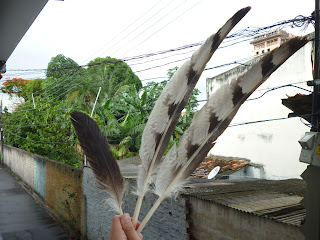The world of the anthropologist is astounding to me. The gift of learning and understanding another culture so different than your own not only enriches your own perception of the world but stays with you for life. My passion in life may be production, but anthropology is still so engrained in my family that I cannot help but be inspired by it everyday.
While in Brazil doing research for his grant, my father has been working closely with a Museum in Belem called Museu Goeldi. This Museum was built for the different indigenous tribes along the Amazon and Xingu River.
Meseu Goeldi is very different than other museums around the area, because they encourage and even pay for the members of the tribes to come and visit the museum, and correct any mistakes they have made through translations or artifacts they have mislabeled. A big project occurring now is one with the Kayapo Indians, headed by Anthropologist Glenn Shepard.
Lucky for me, I arrived to Belem just about the exact same time 3 members of the Kayapo Indians arrived from their village off the Xingu River. I had heard about the Kayapo Indians, and knew they were known for their traditional dress. This tradition includes elaborate body paintings that often cover men and women from head to toe. It is also common for the men to wear a lip spacer in their bottom lip, however the newer generation has stopped wearing them because of the discomfort they cause.
I could immediately tell who the 3 Kayapos were at first glance, not because of their dress – they were wearing very casual t-shirt and shorts – but because of their manner. They were very reserved, quiet and pensive… trying to take in everything going on around them. Two of the men had long hair pulled back in a pony tail. The older of the three had long, silver hair, kindness overflowing through his eyes, yet the two others seem to look at him with such respect and veneration. He was the Shaman of the tribe, or the spiritual leader.
Earlier that day Glenn said he had shown the Shaman a necklace kept in the artifacts in the museum. This necklace could only be obtained by killing an enemy, and when the Shaman picked it up he immediately went into a trance and started convulsing. When he came to, he told Glenn that his Eagle Spirit told him he could not touch the necklace until it had been blessed.
Later that week the Shaman approached me and my parents. He reached in a bag and pulled out 3 eagle feathers. He told us that these feathers will bring luck and goodness to whoever they have been given to. All 3 of us felt truly honored that he chose to give us those feathers.
My dad noticed while we were all eating lunch in the museum cafeteria, it was a little bit difficult for the Kayapo to know the culture of Brazilians from the city of Belem. They were understanding pay by the weight system and buffet style servicing. Instead just walked up to the chicken that was cooking on the grill, and grabbed it; Which was followed by a stern, but understanding looks from the cashier.
But the most interesting thing that day was what happened before lunch. The Kayapo noticed the headdresses in the museum were broken. So they told Glenn and the others that they would make them some more out of palm thatch leaves. To them, this was their responsibility… this is where their history of their tribe was being conserved, this museum was theirs… it belonged just as much to the Kayapo.
They not only gathered the material, cut the excess off, and made two new headdresses… they also wanted to show us the traditional dance they do when wearing the headdresses. As they danced in the middle of the Museo Goeldi outdoor area, I realized this was truly one of a kind and an experience I never would have had, and a group of people I never would have known about had it not been for the passion of Anthropologists and the open minded nature of people from all different countries, cities, and tribes.









No comments:
Post a Comment